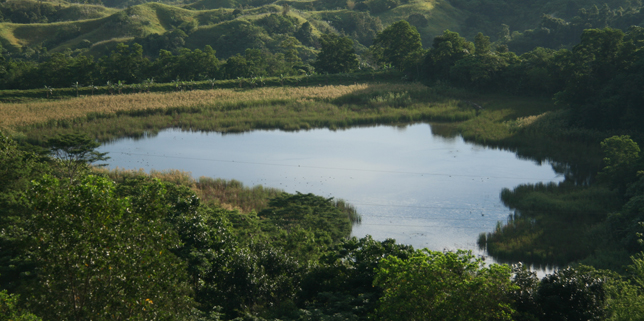
Philex Mining pursues ANR in Bulawan refo program

Bulawan’s rehabilitated Tailings Pond 1, whose surrounding area has been reforested with various tree species (Oct. 2012) | BF
Philex Mining pursues ANR in Bulawan refo program
Friday, February 21, 2014
1M trees planted in 821 hectares in Sipalay between 1995 and 2013
The Bulawan Project of Philex Mining Corp. has vowed to continue with its reforestation program in the central Philippines using both the conventional and the assisted natural regeneration (ANR) processes, which resulted to a total of 138,349 trees planted across 333.24 hectares of land between 2012 and 2013.
Agustin Parcon, assistant manager for the Environment at Bulawan, said in a report that conventional reforestation and ANR involved 14,220 and 65,964 trees planted respectively in 23 and 164.78 hectares of land in 2012, as well as 25,284 and 32,881 trees planted in 63.21 and 82.25 hectares in 2013.
He added that Bulawan, which is being operated by Philex Gold Philippines, Inc. (PGPI), a Philex Mining subsidiary, in Sipalay City and Hinobaan town, both in Negros Occidental, started pursuing ANR, which is the protection of natural tree seedlings in forested areas, in line with the company•s commitment for environmental conservation.
Through ANR, we have been able to liberate the endemic tree species from undesirable grasses, helping them to further grow naturally,• he stressed, explaining that ANR is a cost-saving approach to reforestation, as this calls for the enhancement of the so-called second growth forest dominated by woody species and small trees.
From 1995 to 2011, Bulawan had planted a total of 117,488 trees in 487.99 hectares of land, bringing to a total of 956,992 the number of trees planted in 574.29 hectares until 2013 through conventional reforestation. The figures translate to 1.06 million trees planted across 821.32 hectares in Sipalay City•s Sitio Alegre, Barangay Nabulao, and in Brgy. Bacuyangan, Hinobaan, for the same 19-year period.
Mr. Parcon said that most of the trees that Bulawan had planted were acacia mangium, plus mahogany, samania saman (rain tree), lumbang, and sangil. Also used in the reforestation program were fruit trees, such as marang and jackfruit. Endemic to Australia, Papua New Guinea, and Indonesia, mangium is known as a •nurse species,• owing to its characteristics that add nutrients to the soil. Mangium is usually planted during the first stage of reforestation, in order to pave the way for the planting of other trees, both endemic and exotic to the Philippines.
Bulawan, which PGPI operated for seven years from Jan. 1996, has continued with its reforestation program even after 2002, when production was stopped because of low metal prices. The operation had disturbed 166 hectares only of its 20,000-hectare tenement area. It is now on a care-and-maintenance phase.

pearly
February 21, 2014wow! were can we get and avail seedlings for the trees mentioned above?